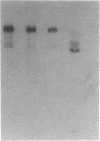Abstract
We have characterized the molecular defect causing androgen resistance in two 46,XY siblings with complete testicular feminization. Although binding studies in genital skin fibroblasts showed a reduced Bmax, an increased dissociation rate of ligand, and an 8S peak of dihydrotestosterone binding on sucrose density gradient centrifugation, no immunoreactive androgen receptor (AR) was detected in immunoblots using anti-NH2-terminal antibodies, suggesting an abnormal amino terminus. Sequence analysis of the AR gene revealed a point mutation CAG-->TAG (Gln-->Stop) at nucleotide 340. In vitro mutagenesis studies suggest the synthesis of the mutant AR is initiated downstream of the termination codon at reduced levels and that each molecule is functionally impaired. These results define a novel mechanism causing androgen resistance: the combination of decreased amount and functional impairment of AR caused by an abnormality within the amino terminus of the receptor. These findings suggest that domains important to the in vivo function of the receptor reside within the amino terminus and that disruption of these domains can occur with only subtle effects on receptor binding. Identification of this mutation made it possible to identify the mutant allele within the family and to ascertain antenatally that it was not present in a 46,XY fetal sibling of the proband at 9 wk gestation.
Full text
PDF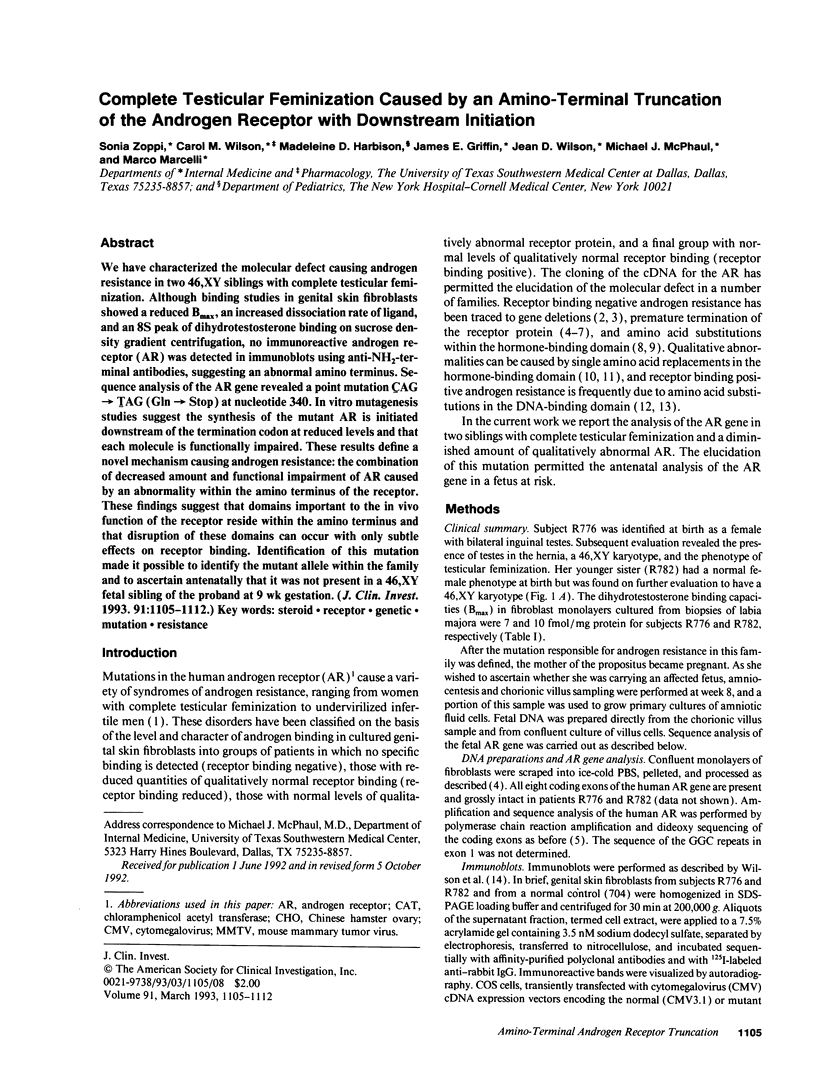

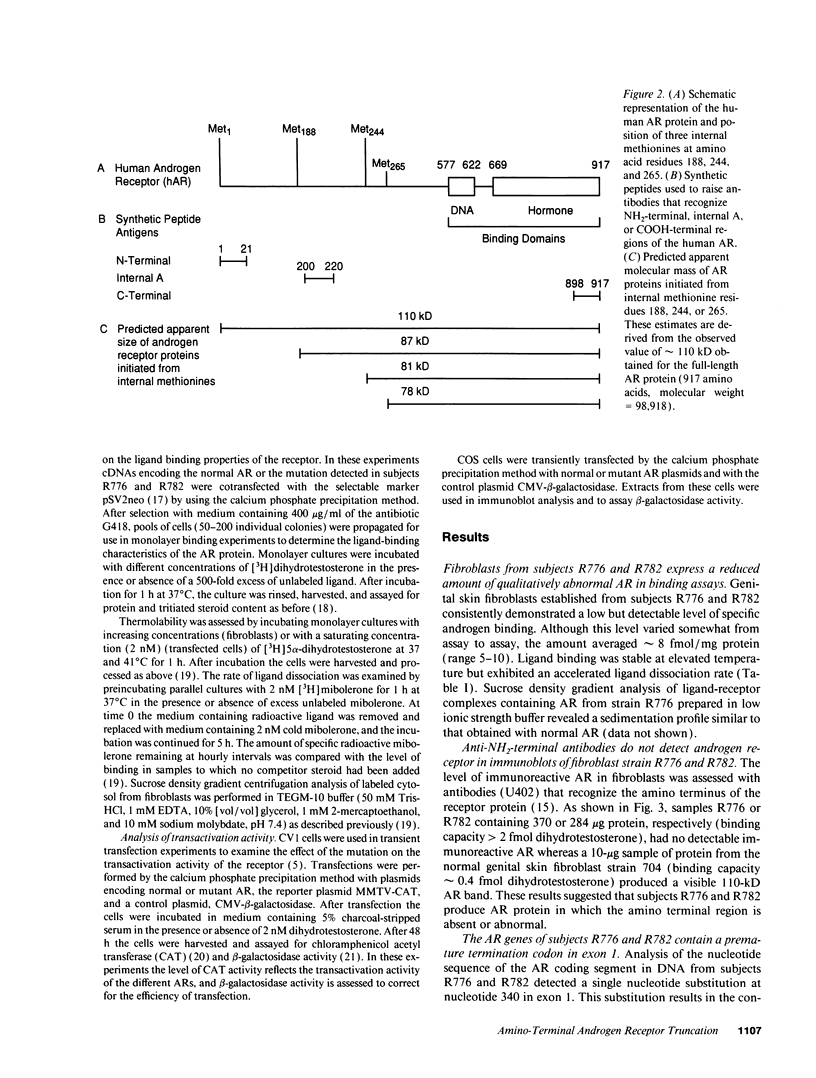

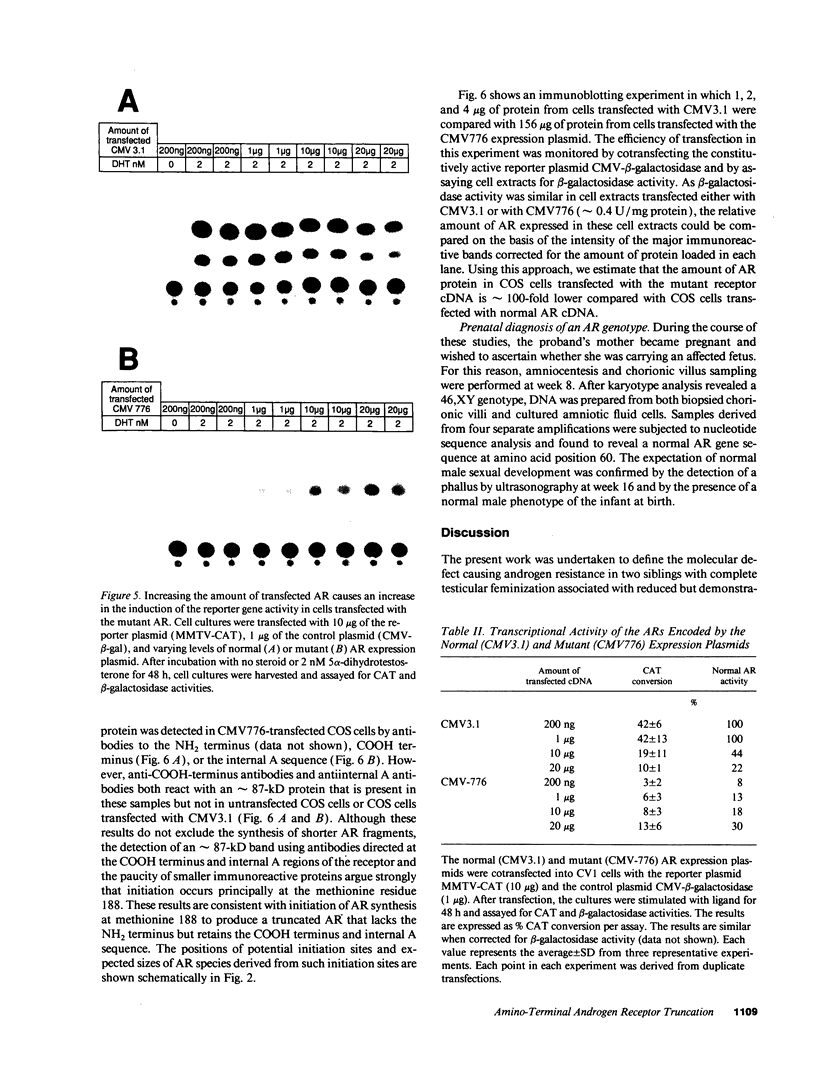
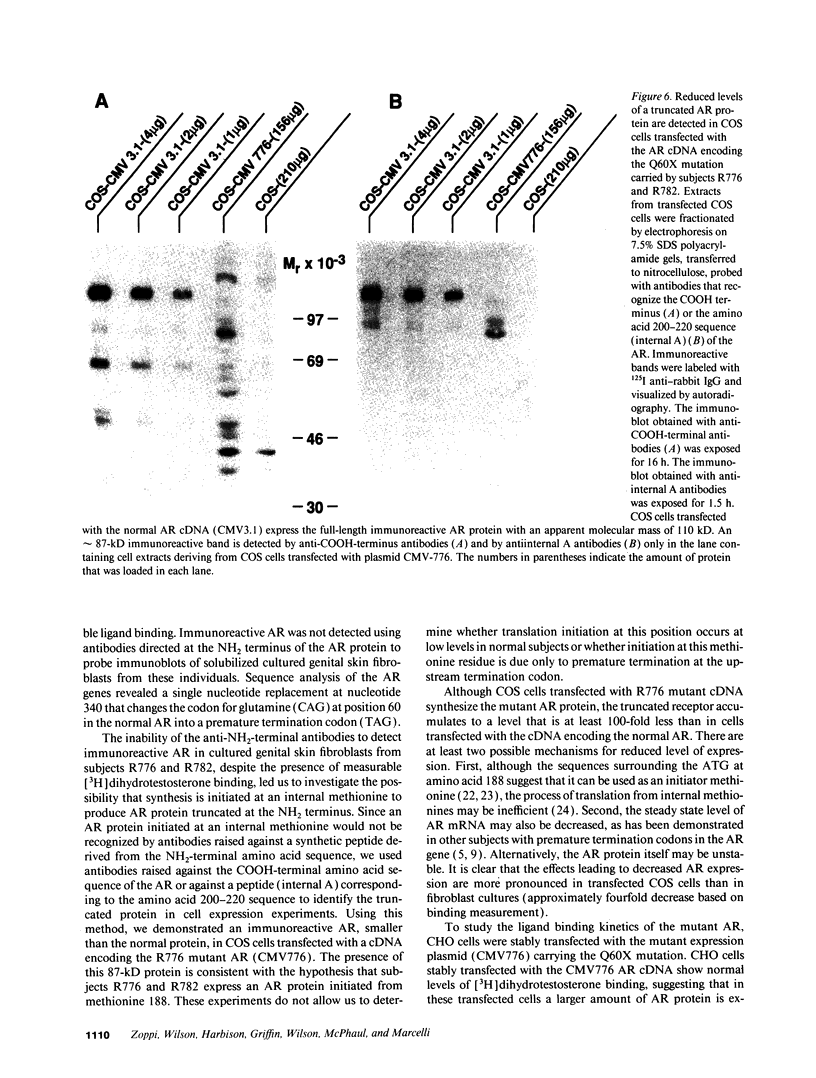
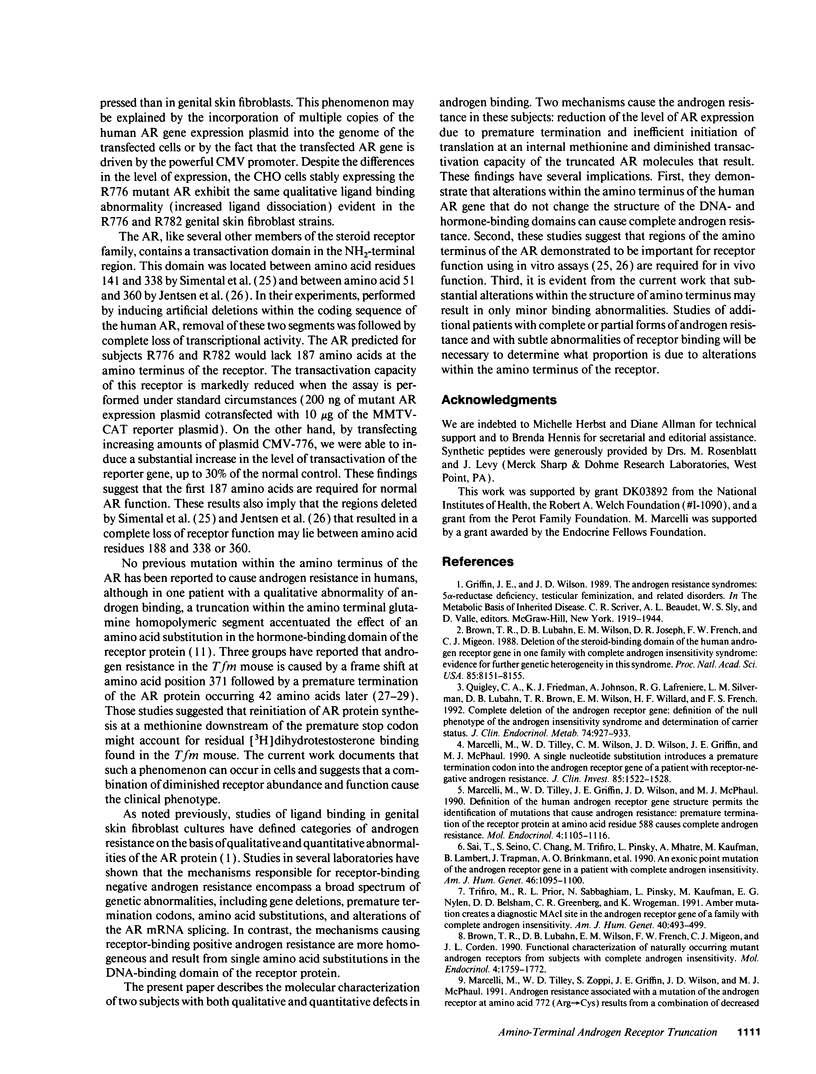

Images in this article
Selected References
These references are in PubMed. This may not be the complete list of references from this article.
- Brown T. R., Lubahn D. B., Wilson E. M., French F. S., Migeon C. J., Corden J. L. Functional characterization of naturally occurring mutant androgen receptors from subjects with complete androgen insensitivity. Mol Endocrinol. 1990 Dec;4(12):1759–1772. doi: 10.1210/mend-4-12-1759. [DOI] [PubMed] [Google Scholar]
- Brown T. R., Lubahn D. B., Wilson E. M., Joseph D. R., French F. S., Migeon C. J. Deletion of the steroid-binding domain of the human androgen receptor gene in one family with complete androgen insensitivity syndrome: evidence for further genetic heterogeneity in this syndrome. Proc Natl Acad Sci U S A. 1988 Nov;85(21):8151–8155. doi: 10.1073/pnas.85.21.8151. [DOI] [PMC free article] [PubMed] [Google Scholar]
- Charest N. J., Zhou Z. X., Lubahn D. B., Olsen K. L., Wilson E. M., French F. S. A frameshift mutation destabilizes androgen receptor messenger RNA in the Tfm mouse. Mol Endocrinol. 1991 Apr;5(4):573–581. doi: 10.1210/mend-5-4-573. [DOI] [PubMed] [Google Scholar]
- Frost E., Williams J. Mapping temperature-sensitive and host-range mutations of adenovirus type 5 by marker rescue. Virology. 1978 Nov;91(1):39–50. doi: 10.1016/0042-6822(78)90353-7. [DOI] [PubMed] [Google Scholar]
- Gaspar M. L., Meo T., Bourgarel P., Guenet J. L., Tosi M. A single base deletion in the Tfm androgen receptor gene creates a short-lived messenger RNA that directs internal translation initiation. Proc Natl Acad Sci U S A. 1991 Oct 1;88(19):8606–8610. doi: 10.1073/pnas.88.19.8606. [DOI] [PMC free article] [PubMed] [Google Scholar]
- Gorman C. M., Moffat L. F., Howard B. H. Recombinant genomes which express chloramphenicol acetyltransferase in mammalian cells. Mol Cell Biol. 1982 Sep;2(9):1044–1051. doi: 10.1128/mcb.2.9.1044. [DOI] [PMC free article] [PubMed] [Google Scholar]
- Griffin J. E., Wilson J. D. Studies on the pathogenesis of the incomplete forms of androgen resistance in man. J Clin Endocrinol Metab. 1977 Dec;45(6):1137–1143. doi: 10.1210/jcem-45-6-1137. [DOI] [PubMed] [Google Scholar]
- Grino P. B., Isidro-Gutierrez R. F., Griffin J. E., Wilson J. D. Androgen resistance associated with a qualitative abnormality of the androgen receptor and responsive to high dose androgen therapy. J Clin Endocrinol Metab. 1989 Mar;68(3):578–584. doi: 10.1210/jcem-68-3-578. [DOI] [PubMed] [Google Scholar]
- Hall C. V., Jacob P. E., Ringold G. M., Lee F. Expression and regulation of Escherichia coli lacZ gene fusions in mammalian cells. J Mol Appl Genet. 1983;2(1):101–109. [PubMed] [Google Scholar]
- He W. W., Kumar M. V., Tindall D. J. A frame-shift mutation in the androgen receptor gene causes complete androgen insensitivity in the testicular-feminized mouse. Nucleic Acids Res. 1991 May 11;19(9):2373–2378. doi: 10.1093/nar/19.9.2373. [DOI] [PMC free article] [PubMed] [Google Scholar]
- Husmann D. A., Wilson C. M., McPhaul M. J., Tilley W. D., Wilson J. D. Antipeptide antibodies to two distinct regions of the androgen receptor localize the receptor protein to the nuclei of target cells in the rat and human prostate. Endocrinology. 1990 May;126(5):2359–2368. doi: 10.1210/endo-126-5-2359. [DOI] [PubMed] [Google Scholar]
- Jenster G., van der Korput H. A., van Vroonhoven C., van der Kwast T. H., Trapman J., Brinkmann A. O. Domains of the human androgen receptor involved in steroid binding, transcriptional activation, and subcellular localization. Mol Endocrinol. 1991 Oct;5(10):1396–1404. doi: 10.1210/mend-5-10-1396. [DOI] [PubMed] [Google Scholar]
- Kozak M. Effects of intercistronic length on the efficiency of reinitiation by eucaryotic ribosomes. Mol Cell Biol. 1987 Oct;7(10):3438–3445. doi: 10.1128/mcb.7.10.3438. [DOI] [PMC free article] [PubMed] [Google Scholar]
- Kozak M. Selection of initiation sites by eucaryotic ribosomes: effect of inserting AUG triplets upstream from the coding sequence for preproinsulin. Nucleic Acids Res. 1984 May 11;12(9):3873–3893. doi: 10.1093/nar/12.9.3873. [DOI] [PMC free article] [PubMed] [Google Scholar]
- Lubahn D. B., Brown T. R., Simental J. A., Higgs H. N., Migeon C. J., Wilson E. M., French F. S. Sequence of the intron/exon junctions of the coding region of the human androgen receptor gene and identification of a point mutation in a family with complete androgen insensitivity. Proc Natl Acad Sci U S A. 1989 Dec;86(23):9534–9538. doi: 10.1073/pnas.86.23.9534. [DOI] [PMC free article] [PubMed] [Google Scholar]
- Marcelli M., Tilley W. D., Wilson C. M., Griffin J. E., Wilson J. D., McPhaul M. J. Definition of the human androgen receptor gene structure permits the identification of mutations that cause androgen resistance: premature termination of the receptor protein at amino acid residue 588 causes complete androgen resistance. Mol Endocrinol. 1990 Aug;4(8):1105–1116. doi: 10.1210/mend-4-8-1105. [DOI] [PubMed] [Google Scholar]
- Marcelli M., Tilley W. D., Wilson C. M., Wilson J. D., Griffin J. E., McPhaul M. J. A single nucleotide substitution introduces a premature termination codon into the androgen receptor gene of a patient with receptor-negative androgen resistance. J Clin Invest. 1990 May;85(5):1522–1528. doi: 10.1172/JCI114599. [DOI] [PMC free article] [PubMed] [Google Scholar]
- Marcelli M., Tilley W. D., Zoppi S., Griffin J. E., Wilson J. D., McPhaul M. J. Androgen resistance associated with a mutation of the androgen receptor at amino acid 772 (Arg----Cys) results from a combination of decreased messenger ribonucleic acid levels and impairment of receptor function. J Clin Endocrinol Metab. 1991 Aug;73(2):318–325. doi: 10.1210/jcem-73-2-318. [DOI] [PubMed] [Google Scholar]
- Marcelli M., Zoppi S., Grino P. B., Griffin J. E., Wilson J. D., McPhaul M. J. A mutation in the DNA-binding domain of the androgen receptor gene causes complete testicular feminization in a patient with receptor-positive androgen resistance. J Clin Invest. 1991 Mar;87(3):1123–1126. doi: 10.1172/JCI115076. [DOI] [PMC free article] [PubMed] [Google Scholar]
- McPhaul M. J., Marcelli M., Tilley W. D., Griffin J. E., Isidro-Gutierrez R. F., Wilson J. D. Molecular basis of androgen resistance in a family with a qualitative abnormality of the androgen receptor and responsive to high-dose androgen therapy. J Clin Invest. 1991 Apr;87(4):1413–1421. doi: 10.1172/JCI115147. [DOI] [PMC free article] [PubMed] [Google Scholar]
- Peabody D. S., Berg P. Termination-reinitiation occurs in the translation of mammalian cell mRNAs. Mol Cell Biol. 1986 Jul;6(7):2695–2703. doi: 10.1128/mcb.6.7.2695. [DOI] [PMC free article] [PubMed] [Google Scholar]
- Quigley C. A., Friedman K. J., Johnson A., Lafreniere R. G., Silverman L. M., Lubahn D. B., Brown T. R., Wilson E. M., Willard H. F., French F. S. Complete deletion of the androgen receptor gene: definition of the null phenotype of the androgen insensitivity syndrome and determination of carrier status. J Clin Endocrinol Metab. 1992 Apr;74(4):927–933. doi: 10.1210/jcem.74.4.1347772. [DOI] [PubMed] [Google Scholar]
- Sai T. J., Seino S., Chang C. S., Trifiro M., Pinsky L., Mhatre A., Kaufman M., Lambert B., Trapman J., Brinkmann A. O. An exonic point mutation of the androgen receptor gene in a family with complete androgen insensitivity. Am J Hum Genet. 1990 Jun;46(6):1095–1100. [PMC free article] [PubMed] [Google Scholar]
- Simental J. A., Sar M., Lane M. V., French F. S., Wilson E. M. Transcriptional activation and nuclear targeting signals of the human androgen receptor. J Biol Chem. 1991 Jan 5;266(1):510–518. [PubMed] [Google Scholar]
- Southern P. J., Berg P. Transformation of mammalian cells to antibiotic resistance with a bacterial gene under control of the SV40 early region promoter. J Mol Appl Genet. 1982;1(4):327–341. [PubMed] [Google Scholar]
- Trifiro M., Prior R. L., Sabbaghian N., Pinsky L., Kaufman M., Nylen E. G., Belsham D. D., Greenberg C. R., Wrogemann K. Amber mutation creates a diagnostic MaeI site in the androgen receptor gene of a family with complete androgen insensitivity. Am J Med Genet. 1991 Sep 15;40(4):493–499. doi: 10.1002/ajmg.1320400425. [DOI] [PubMed] [Google Scholar]
- Wilson C. M., Griffin J. E., Wilson J. D., Marcelli M., Zoppi S., McPhaul M. J. Immunoreactive androgen receptor expression in subjects with androgen resistance. J Clin Endocrinol Metab. 1992 Dec;75(6):1474–1478. doi: 10.1210/jcem.75.6.1464650. [DOI] [PubMed] [Google Scholar]
- Zoppi S., Marcelli M., Deslypere J. P., Griffin J. E., Wilson J. D., McPhaul M. J. Amino acid substitutions in the DNA-binding domain of the human androgen receptor are a frequent cause of receptor-binding positive androgen resistance. Mol Endocrinol. 1992 Mar;6(3):409–415. doi: 10.1210/mend.6.3.1316540. [DOI] [PubMed] [Google Scholar]









